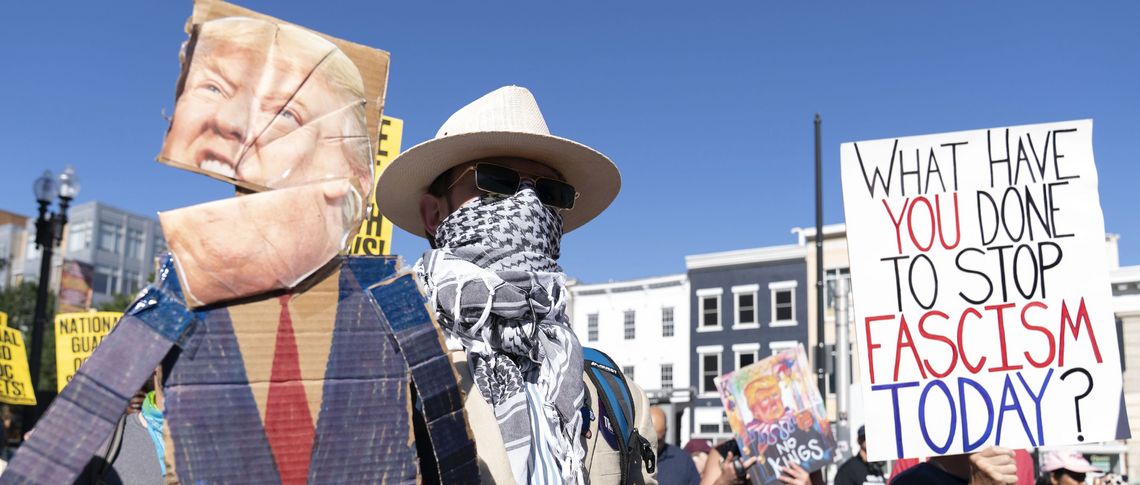The ‘fight against the right’ is often portrayed by the left as a matter of life or death, as democracy versus fascism: if the fight is lost, then it would spell the end of democracy and fascism would reign again. That was the stark warning published in a global manifesto signed by 400 intellectuals.
But does this framing actually work? Will it help to defend democracy and win back lost voters? Probably not. In fact, it may do more harm than good. There are plenty of reasons why this fascism framing will backfire. Here are six of them:
First, this framing rests on flimsy foundations. It presumes that Europe is once again locked in a desperate fight against extremism, exactly as it was in the 1920s. The warning in the ‘Manifesto against the Return of Fascism’ draws several parallels between 1925 and 2025. In Germany’s 2025 election campaign, one slogan read: ‘Voting for the right is so 1933.’
Europe’s democracies have changed dramatically over the last century.
But these comparisons reveal a lack of historical awareness. Europe’s democracies have changed dramatically over the last century. Unlike the fragile systems that existed between the two world wars, democratic systems today are decidedly stronger and more resilient. They do have their weaknesses, of course, but they are not teetering on collapse as they were a hundred years ago. Democracies in Europe (with the exception of Hungary) are among the most robust in the world.
And this misframing has consequences too: those who see democracy as fighting for its very survival believe more drastic measures are required, from state surveillance to banning political parties, and even curbing freedom of speech. But a strong democracy thrives on open debate and the power of persuasion. Emergency powers should only ever be the exception, not the rule, as they can easily push opponents further away and undermine the concept of fair play. In the long run, these tactics only corrode a democracy’s credibility.
Second, the fascism narrative undermines a key tenet of democracy: the idea that radical parties can become more moderate and cease posing an existential threat. They may still hold controversial views, but can nonetheless play by the democratic rulebook.
In the post-war decades, many Communist parties shifted from global revolutionaries to a distinctly European brand of reformist Euro-communism. Similarly, several far-right parties have repositioned themselves. The Sweden Democrats notably apologised for their neo-Nazi roots. Even approaching this cautiously, that shift can still be appreciated as a democratic win.
If radical parties play by the democratic rules, they can and should be allowed into government.
To protect democracy, it is vital for us to learn from these examples, to recognise when parties become more moderate and even reward them. If radical parties play by the democratic rules, they can and should be allowed into government. Fascism framing, however, suggests the opposite: that perpetual radicalisation is the only possible outcome.
Third, this label only narrows political debate. Once you brand someone a fascist, you have pushed them outside the democratic tent. And who exactly would we class as fascist? Trump’s MAGA movement? Germany’s centre-right CDU, if it ever voted with the far-right AfD? Austria’s Social Democrats, if they formed a coalition with the far-right FPÖ?
Shutting down the space for debate is a recipe for disaster. Democracies thrive on debate, especially with extremes and especially when society itself is drifting apart. What’s more, constantly labelling people as fascists only makes them more resentful at the fact that they are not being listened to, but lectured. That plays straight into the hands of the far right.
Fourth, for Republicans in the US and many of Europe’s right-wing populists, Europe has become a hotspot for digital censorship, overreaching bureaucrats, the undemocratic ostracisation of populist parties and rigged elections. At the Munich Security Conference, J.D. Vance hammered these points home, later echoed by the US State Department. Much of this criticism is blatantly strategic, partisan and hardly credible, especially when Hungary is held up as a model. That does not mean it should be dismissed as part of some ‘fascist playbook’. In this fundamental debate, it is better to scrutinise arguments, identify contradictions and respond calmly. That is what convinces voters.
Open debate on freedom of speech, elections, direct democracy, and checks and balances is not only sensible but necessary, especially in the face of a polarising and often undemocratic US administration. Yes, Europe has its own questionable restrictions on freedom of expression, and Romania’s recent presidential election did raise some eyebrows, but Europe can still lead this discussion with composure.
Many people simply no longer feel represented by mainstream parties, resulting in a genuine representation gap.
The COMPACT ruling by Germany’s Federal Administrative Court shows how far freedom of expression extends in the country. Another prime example is how the AfD is allowed to hold events in the German Parliament’s committee rooms, where it claims that freedom of expression is being stifled, just as it was in the old East Germany — a distorted and ironic view of history, given those kinds of events would never have been allowed there.
Fifth, the fascism framing suggests that the far right radicalises all by itself, fuelled by misinformation, media moguls and echo chambers. But this is an oversimplified view that overlooks certain aspects. The far right is becoming more radicalised within its own bubbles, but there are also progressive contributions when it comes to polarisation, and also progressives often take too negative a view of their political opponents. And the structure of the political system itself ‒ whether it rewards moderation or pushes parties further to the fringe ‒ plays a critical role. Crucially, many people simply no longer feel represented by mainstream parties, resulting in a genuine representation gap.
The ‘fight against the right’ narrative is itself a symptom of that gap. It appeals mainly to those who see anti-fascism as a political identity in itself. But across Europe, most people don’t define themselves that way, or are not especially interested in politics at all. In the current European Parliament, conservatives, liberals and the far right together hold nearly two-thirds of the seats. And nearly half of all eligible citizens didn’t vote in the last election. In other words, this framing is fishing in an empty pond. Worse still, it alienates exactly those voters who have drifted from the left to the right — the very ones who need to be won back.
The best tool to defend democracy is open, calm debate rather than fear-driven fascism framing.
Sixth, fascism framing implies that there is only one type, a kind of international fascism. The far right in Europe and the US clearly do work closely together. The US State Department’s talk of ‘civilisational allies in Europe’ and the Trump administration’s electioneering support for right-wing populists here are evidence enough. But ideological similarities do not mean that all fascisms are equal.
Right-wing parties on both sides of the Atlantic differ not only in their stance towards Russia, but also in their very understanding of democracy. Over in the States, Republicans have radicalised considerably, showing increasingly undemocratic contempt for elections, as well as checks and balances. In much of Europe, the picture is different: in Scandinavia, the Netherlands, Austria, Switzerland and Italy, far-right parties have long traditions of winning, losing and ‒ crucially ‒ accepting the outcome of elections. Unlike in Hungary or the US, their time in office has not yet eroded democracy itself. And the cult of personality around Donald Trump has no real European equivalent.
For democracy, these distinctions matter. To lump all moderates and extremists together under the banner of fascism removes any nuance and blurs critical lines. In political debate, we need to highlight the differences and contradictions on the far right, not pretend they are one indistinguishable mass.
In short, the best tool to defend democracy is open, calm debate rather than fear-driven fascism framing. We should specifically illustrate successes as well as the problems and dangers. Above all, extremists need to be included in these debates. This does not mean that all opinions are acceptable in a democracy. There are limits, which are quite clearly defined in national law, international law and UN resolutions. But when in doubt, diversity of opinion and pluralism take precedence. In a time of profound polarisation, we don’t need a ‘Manifesto against the Return of Fascism’, we need a ‘Manifesto for Pluralism’.






